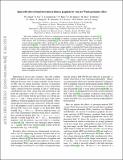Spin–orbit-driven band inversion in bilayer graphene by the van der Waals proximity effect
Author(s)
Island, JO; Cui, X; Lewandowski, Cyprian Krzysztof; Khoo, Jun Yong; Spanton, EM; Zhou, H; Rhodes, D; Hone, JC; Taniguchi, T; Watanabe, K; Levitov, Leonid; Zaletel, MP; Young, AF; ... Show more Show less
DownloadSubmitted version (4.591Mb)
Publisher Policy
Publisher Policy
Article is made available in accordance with the publisher's policy and may be subject to US copyright law. Please refer to the publisher's site for terms of use.
Terms of use
Metadata
Show full item recordAbstract
© 2019, The Author(s), under exclusive licence to Springer Nature Limited. Spin–orbit coupling (SOC) is the key to realizing time-reversal-invariant topological phases of matter1,2. SOC was predicted by Kane and Mele3 to stabilize a quantum spin Hall insulator; however, the weak intrinsic SOC in monolayer graphene4–7 has precluded experimental observation in this material. Here we exploit a layer-selective proximity effect—achieved via a van der Waals contact with a semiconducting transition-metal dichalcogenide8–21—to engineer Kane–Mele SOC in ultra clean bilayer graphene. Using high-resolution capacitance measurements to probe the bulk electronic compressibility, we find that SOC leads to the formation of a distinct, incompressible, gapped phase at charge neutrality. The experimental data agree quantitatively with a simple theoretical model in which the new phase results from SOC-driven band inversion. In contrast to Kane–Mele SOC in monolayer graphene, the inverted phase is not expected to be a time-reversal-invariant topological insulator, despite being separated from conventional band insulators by electric-field-tuned phase transitions where crystal symmetry mandates that the bulk gap must close22. Our electrical transport measurements reveal that the inverted phase has a conductivity of approximately e2/h (where e is the electron charge and h Planck’s constant), which is suppressed by exceptionally small in-plane magnetic fields. The high conductivity and anomalous magnetoresistance are consistent with theoretical models that predict helical edge states within the inverted phase that are protected from backscattering by an emergent spin symmetry that remains robust even for large Rashba SOC. Our results pave the way for proximity engineering of strong topological insulators as well as correlated quantum phases in the strong spin–orbit regime in graphene heterostructures.
Date issued
2019Department
Massachusetts Institute of Technology. Department of PhysicsJournal
Nature
Publisher
Springer Science and Business Media LLC